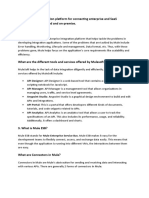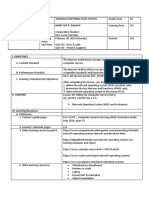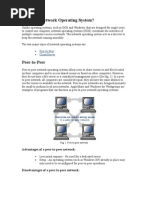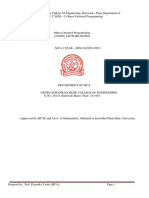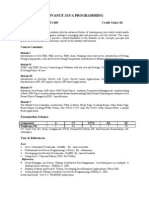CSS - 06-Module 6.1 - Network Operating System
Uploaded by
Morelei FernandezCSS - 06-Module 6.1 - Network Operating System
Uploaded by
Morelei FernandezRead the Information Sheet 6.
1 carefully and at the end of
this sheet there will be a Self-check to measure how much
you’ve learned and remembered.
INFORMATION SHEET No. 6.1
NETWORK OPERATING SYSTEM (NOS)
Learning Objectives:
After reading this Information Sheet, you should be able to:
Define network operating system (NOS),
Identify the different types of network operating system,
Differentiate the Peer to Peer and Client-Server operating system
What is a Network Operating System?
Network Operating System is a computer operating system that
facilitates to connect and communicate various autonomous computers
over a network. An Autonomous computer is an independent computer
that has its own local memory, hardware, and O.S. It is self-capable to
perform operations and processing for a single user. They can either run the
same or different O.S.
The Network O.S. mainly runs on a powerful computer, that runs the server
program. It facilitates the security and capability of managing the data,
user, group, application, and other network functionalities. The main
advantage of using a network o.s. is that it facilitates the sharing of
resources and memory amongst the autonomous computers in the network.
It can also facilitate the client computers to access the shared memory and
resources administered by the Server computer. In other words, the Network
O.S. is mainly designed to allow multiple users to share files and resources
over the network.
Computer System Servicing
G12 – Technical-Vocational-Livelihood (TVL) Track Page 1
The Network O.S. is not transparent in nature. The workstations connected
in the network are aware of the multiplicity of the network devices. The
Network Operating Systems can distribute their tasks and functions
amongst connected nodes in the network, which enhances the system
overall performance. It can allow multiple access to the shared resources
concurrently, which results in efficiency. One of the major importance of
using a Network O.S. is remote access. It facilitates one workstation to
connect and communicate with another workstation in a secure manner.
For providing security, it has authentication and access control
functionality. The network o.s. implements a lot of protocols over the
network, which provides a proper implementation of the network
functionalities. One drawback of Network O.S. is its tightly coupled nature
in the network.
Some examples of Network O.S. are Novel Netware, Microsoft Windows
server (2000, 2003, 2008), Unix, Linux, etc.
There are mainly two types of Network O.S., they are:
1. Peer-to-Peer
2. Client-Server
Peer-to-Peer Network Operating Systems allow users to share resources
and files located on their computers and to access shared resources found on
other computers. However, they do not have a file server or a centralized
management source (See fig. 1). In a peer-to-peer network, all computers are
considered equal; they all have the same abilities to use the resources
available on the network. Peer-to-peer networks are designed primarily for
small to medium local area networks. Nearly all modern desktop operating
systems, such as Macintosh OSX, Linux, and Windows, can function as peer-
to-peer network operating systems.
Following are the advantages of the Peer-to-Peer Network Operating
System:
1. Easy to install and setup.
2. The setup cost is low.
3. There is no requirement for any specialized software.
4. The sharing of information and resources is fast and easy.
Following are the disadvantages of the Peer-to-Peer Network Operating
System:
1. The performance of autonomous computers may not be so good when
sharing some resources.
2. There is no centralized management.
3. It is less secure.
4. It does not have backup functionalities.
5. There is no centralized storage system.
Computer System Servicing
G12 – Technical-Vocational-Livelihood (TVL) Track Page 2
Fig. 1. Peer-to-peer network
Client-Server Networking Operating System operates with a single server
and multiple client computers in the network. The Client O.S. runs on the
client machine, while the Network Operating System is installed on the
server machine. The server machine is a centralized hub for all the client
machines. The client machines generate a request for information or some
resource and forward it to the server machine. The server machine, in turn,
replies to the client machine by providing appropriate services to it in a
secure manner. The server machine is a very powerful computer, that is
capable of tackling large calculations and operations. It can also have the
ability to administer the whole network and its resources. It can be
multiprocessing in nature, which can process multiple client requests at the
same time. The Network O.S. enhances the reach of client machines by
providing remote access to other nodes and resources of the network in a
secure manner.
Client/server network operating systems allow the network to centralize
functions and applications in one or more dedicated file servers (See fig. 2).
The file servers become the heart of the system, providing access to resources
and providing security. Individual workstations (clients) have access to the
resources available on the file servers. The network operating system provides
the mechanism to integrate all the components of the network and allow
multiple users to simultaneously share the same resources irrespective of
physical location. UNIX/Linux and the Microsoft family of Windows Servers
are examples of client/server network operating systems.
Fig. 2. Client/server network
Computer System Servicing
G12 – Technical-Vocational-Livelihood (TVL) Track Page 3
Following are the advantages of the Client-Server Network Operating
System:
1. It has centralized control and administration.
2. It has a backup facility for lost data.
3. The shared data and resources can be accessed concurrently by
multiple clients.
4. It has better reliability and performance.
Following are the disadvantages of the Client-Server Network Operating
System:
1. The setup cost is very high.
2. There is a requirement of specialized software for client and server
machines to function properly.
3. There is a need for an administrator to administer the network.
4. There may be network failure, in case of central server failure.
5. A huge amount of client requests may overload the server.
Note: For further study watch this video presentation in youtube.com
Title: Network Operating System uploaded by Captain Android.
Here is the link: https://www.youtube.com/watch?v=y0x_dOkOU5o
Title: What is Peer to Peer (P2P) uploaded by Sense Chat.
Here is the link: https://www.youtube.com/watch?v=s-Fs_Ucy_EU&fbclid=IwAR1GiGDQS-
dxZJLyyqO6jvFqIj7ZvJpJ1hrxGawKL_25O6clUwrjfRdKDwI
Electronic references:
Network Operating System uploaded by Captain Android
https://www.youtube.com/watch?v=4_zSIXb7tLQ
Afteracademy.com - what-is-a-network-operating-system?
https://afteracademy.com/blog/what-is-a-network-operating-system
https://fcit.usf.edu/network/chap6/chap6.htm#:~:text=Peer%2Dto%2Dpeer%20network%20operatin
g,centralized%20management%20source%20(See%20fig.
Computer System Servicing
G12 – Technical-Vocational-Livelihood (TVL) Track Page 4
Self-Check 6.1
Multiple Choice:
Directions: Read the statement carefully and choose the correct answer for
each item. Write the letter of your answer on the space provided before each
number.
______1. It allows the network to centralize functions and applications in one or more
dedicated file server.
A. Peer to Peer C. Operating System
B. Client-Server D. Network System
______2. It is a computer operating system that facilitates to connect and
communicate various autonomous computers over a network.
A. Peer to Peer network C. Network Operating System
B. Windows operating D. Client-Server network
______3. It allows users to share resources and files located on their computers
and to access shared resources found on other computers.
A. Peer to Peer C. Operating System
B. Client-Server D. Network System
______4. It operates with a single server and multiple client computers in the
A. Operating System C. Peer to Peer
B. Client-Server D. Network System
______5. The two types of network operating system are;
A. Windows 7 and 10 C. Peer to Peer and Client-Server
B. Linux and Server D. Windows and Linux
TRUE OF FALSE
Directions: Read the statement carefully and choose the correct answer for
each item. Write T if the statement is True and F if the statement is False.
______6. Peer-to-Peer Network Operating System is easy to install and setup.
______7. There is no requirement of specialized software for client and server
machines to function properly.
______8. In Client-Server, there may be network failure, in case of central
server failure.
______9. Peer-to-Peer Network Operating System have a centralized
management of file services.
______10. In Client-Server, the shared data and resources can be accessed
concurrently by multiple clients.
Computer System Servicing
G12 – Technical-Vocational-Livelihood (TVL) Track Page 5
You might also like
- Achievement Chart: Computer Systems Servicing NC IINo ratings yetAchievement Chart: Computer Systems Servicing NC II4 pages
- Set router/Wi-Fi/wireless Access Point/repeater Configuration100% (1)Set router/Wi-Fi/wireless Access Point/repeater Configuration13 pages
- Computer System Servicing Grade 12: S H S Plan Maintenance And/or Diagnosis of Faults in Line With Job Requirements17% (6)Computer System Servicing Grade 12: S H S Plan Maintenance And/or Diagnosis of Faults in Line With Job Requirements15 pages
- Mulesoft Is An Integration Platform For Connecting Enterprise and Saas Applications in The Cloud and On-Premise. What Is Mule?No ratings yetMulesoft Is An Integration Platform For Connecting Enterprise and Saas Applications in The Cloud and On-Premise. What Is Mule?8 pages
- DEFECTS IN COMPUTER SYSTEM AND NETWORKS - Week 10100% (1)DEFECTS IN COMPUTER SYSTEM AND NETWORKS - Week 1025 pages
- TVL-ICT (Computer System Servicing) Activity Sheet Quarter 2 - Lesson 3100% (1)TVL-ICT (Computer System Servicing) Activity Sheet Quarter 2 - Lesson 311 pages
- "Configuring Wireless Access Point" (Quick Setup)No ratings yet"Configuring Wireless Access Point" (Quick Setup)15 pages
- WW-CSS 9-Install Operating System and Drivers For Peripherals-Devices100% (1)WW-CSS 9-Install Operating System and Drivers For Peripherals-Devices55 pages
- Quarter 3 - Module 1-W3: Computer Systems Servicing (CSS)No ratings yetQuarter 3 - Module 1-W3: Computer Systems Servicing (CSS)3 pages
- Student Handout 3 How To Assemble and Disassemble PC88% (8)Student Handout 3 How To Assemble and Disassemble PC12 pages
- Lesson Plan in Ict/ Computer Systems Servicing-10: I. ObjectiveNo ratings yetLesson Plan in Ict/ Computer Systems Servicing-10: I. Objective4 pages
- Competency-Based Learning Materials: Information and Communication TechnologyNo ratings yetCompetency-Based Learning Materials: Information and Communication Technology28 pages
- Module 2 - Setting-Up Computer NetworksNo ratings yetModule 2 - Setting-Up Computer Networks25 pages
- Computer Systems Servicing Grade 12: Summative Test 1 QuarterNo ratings yetComputer Systems Servicing Grade 12: Summative Test 1 Quarter8 pages
- Computer Systems Servicing 2nd Quarter ReviewerNo ratings yetComputer Systems Servicing 2nd Quarter Reviewer2 pages
- 12ICT-CSS - 05 ORIENTATION and Network Design PresentationNo ratings yet12ICT-CSS - 05 ORIENTATION and Network Design Presentation16 pages
- Installer Preparation and Creating Bootable Devices100% (5)Installer Preparation and Creating Bootable Devices17 pages
- Department of Education - Final Exam CSS Grade 11 1st SemNo ratings yetDepartment of Education - Final Exam CSS Grade 11 1st Sem1 page
- Install Operating System and Drivers For Peripherals50% (2)Install Operating System and Drivers For Peripherals5 pages
- Configuring of Computer Systems and NetworksNo ratings yetConfiguring of Computer Systems and Networks73 pages
- Activity Performance Worksheet In: Computer Systems Servicing100% (1)Activity Performance Worksheet In: Computer Systems Servicing8 pages
- Maintaining of Computer Systems and Networks68% (22)Maintaining of Computer Systems and Networks41 pages
- Lecture Notes Unit-1 (Network Operating System) : Session: 2021-22No ratings yetLecture Notes Unit-1 (Network Operating System) : Session: 2021-2221 pages
- 3rd Quarter Compendium of Notes Grade 9 ICTNo ratings yet3rd Quarter Compendium of Notes Grade 9 ICT37 pages
- Gret-Fisico BLDG., Maharlika Highway, Brgy. Lumingon, Tiaong, Quezon, Philippines Telefax Number: (042) - 545-6547 / Cell No. 0922-8934738No ratings yetGret-Fisico BLDG., Maharlika Highway, Brgy. Lumingon, Tiaong, Quezon, Philippines Telefax Number: (042) - 545-6547 / Cell No. 0922-89347383 pages
- What Are The Marketing Mix /how To Develop An Effective Marketing Mix The Seven P's of The Marketing Mix Worksheet 6No ratings yetWhat Are The Marketing Mix /how To Develop An Effective Marketing Mix The Seven P's of The Marketing Mix Worksheet 64 pages
- Viability, Profitability, and Customer Requirements and Best Product For Market NeedNo ratings yetViability, Profitability, and Customer Requirements and Best Product For Market Need3 pages
- Gret-Fisico BLDG., Maharlika Highway, Brgy. Lumingon, Tiaong, Quezon, Philippines Telefax Number: (042) - 545-6547 / Cell No. 0922-8934738No ratings yetGret-Fisico BLDG., Maharlika Highway, Brgy. Lumingon, Tiaong, Quezon, Philippines Telefax Number: (042) - 545-6547 / Cell No. 0922-89347383 pages
- Lesson 10: Demonstrate Understanding of The 4Ms of Operations Worksheet 8No ratings yetLesson 10: Demonstrate Understanding of The 4Ms of Operations Worksheet 83 pages
- Maxon One User Guide: Get The Promo Code From Your OrderNo ratings yetMaxon One User Guide: Get The Promo Code From Your Order7 pages
- Software Engineering: Mudassar Mahmood MirzaNo ratings yetSoftware Engineering: Mudassar Mahmood Mirza12 pages
- Core 1 - Install and Configure Computer SystemNo ratings yetCore 1 - Install and Configure Computer System6 pages
- (Appendix) CR-IR391 CL PC Setup GuidelineNo ratings yet(Appendix) CR-IR391 CL PC Setup Guideline8 pages
- 14th International Conference On Information Technology: New Generations (ITNG 2017)No ratings yet14th International Conference On Information Technology: New Generations (ITNG 2017)16 pages
- Configure or Change Fxos Password Firepower 2100No ratings yetConfigure or Change Fxos Password Firepower 21003 pages
- How To Choose Best Wordpress Hosting For Your WebsiteNo ratings yetHow To Choose Best Wordpress Hosting For Your Website5 pages
- HTML - Draw An X in CSS - Stack OverflowNo ratings yetHTML - Draw An X in CSS - Stack Overflow14 pages
- Chapter 1-Introduction To Android PlatformNo ratings yetChapter 1-Introduction To Android Platform20 pages
- Achievement Chart: Computer Systems Servicing NC IIAchievement Chart: Computer Systems Servicing NC II
- Set router/Wi-Fi/wireless Access Point/repeater ConfigurationSet router/Wi-Fi/wireless Access Point/repeater Configuration
- Computer System Servicing Grade 12: S H S Plan Maintenance And/or Diagnosis of Faults in Line With Job RequirementsComputer System Servicing Grade 12: S H S Plan Maintenance And/or Diagnosis of Faults in Line With Job Requirements
- Mulesoft Is An Integration Platform For Connecting Enterprise and Saas Applications in The Cloud and On-Premise. What Is Mule?Mulesoft Is An Integration Platform For Connecting Enterprise and Saas Applications in The Cloud and On-Premise. What Is Mule?
- TVL-ICT (Computer System Servicing) Activity Sheet Quarter 2 - Lesson 3TVL-ICT (Computer System Servicing) Activity Sheet Quarter 2 - Lesson 3
- WW-CSS 9-Install Operating System and Drivers For Peripherals-DevicesWW-CSS 9-Install Operating System and Drivers For Peripherals-Devices
- Quarter 3 - Module 1-W3: Computer Systems Servicing (CSS)Quarter 3 - Module 1-W3: Computer Systems Servicing (CSS)
- Student Handout 3 How To Assemble and Disassemble PCStudent Handout 3 How To Assemble and Disassemble PC
- Lesson Plan in Ict/ Computer Systems Servicing-10: I. ObjectiveLesson Plan in Ict/ Computer Systems Servicing-10: I. Objective
- Competency-Based Learning Materials: Information and Communication TechnologyCompetency-Based Learning Materials: Information and Communication Technology
- Computer Systems Servicing Grade 12: Summative Test 1 QuarterComputer Systems Servicing Grade 12: Summative Test 1 Quarter
- 12ICT-CSS - 05 ORIENTATION and Network Design Presentation12ICT-CSS - 05 ORIENTATION and Network Design Presentation
- Installer Preparation and Creating Bootable DevicesInstaller Preparation and Creating Bootable Devices
- Department of Education - Final Exam CSS Grade 11 1st SemDepartment of Education - Final Exam CSS Grade 11 1st Sem
- Install Operating System and Drivers For PeripheralsInstall Operating System and Drivers For Peripherals
- Activity Performance Worksheet In: Computer Systems ServicingActivity Performance Worksheet In: Computer Systems Servicing
- Lecture Notes Unit-1 (Network Operating System) : Session: 2021-22Lecture Notes Unit-1 (Network Operating System) : Session: 2021-22
- Gret-Fisico BLDG., Maharlika Highway, Brgy. Lumingon, Tiaong, Quezon, Philippines Telefax Number: (042) - 545-6547 / Cell No. 0922-8934738Gret-Fisico BLDG., Maharlika Highway, Brgy. Lumingon, Tiaong, Quezon, Philippines Telefax Number: (042) - 545-6547 / Cell No. 0922-8934738
- What Are The Marketing Mix /how To Develop An Effective Marketing Mix The Seven P's of The Marketing Mix Worksheet 6What Are The Marketing Mix /how To Develop An Effective Marketing Mix The Seven P's of The Marketing Mix Worksheet 6
- Viability, Profitability, and Customer Requirements and Best Product For Market NeedViability, Profitability, and Customer Requirements and Best Product For Market Need
- Gret-Fisico BLDG., Maharlika Highway, Brgy. Lumingon, Tiaong, Quezon, Philippines Telefax Number: (042) - 545-6547 / Cell No. 0922-8934738Gret-Fisico BLDG., Maharlika Highway, Brgy. Lumingon, Tiaong, Quezon, Philippines Telefax Number: (042) - 545-6547 / Cell No. 0922-8934738
- Lesson 10: Demonstrate Understanding of The 4Ms of Operations Worksheet 8Lesson 10: Demonstrate Understanding of The 4Ms of Operations Worksheet 8
- Maxon One User Guide: Get The Promo Code From Your OrderMaxon One User Guide: Get The Promo Code From Your Order
- 14th International Conference On Information Technology: New Generations (ITNG 2017)14th International Conference On Information Technology: New Generations (ITNG 2017)
- How To Choose Best Wordpress Hosting For Your WebsiteHow To Choose Best Wordpress Hosting For Your Website







